#egyptian hieroglyphs
Text


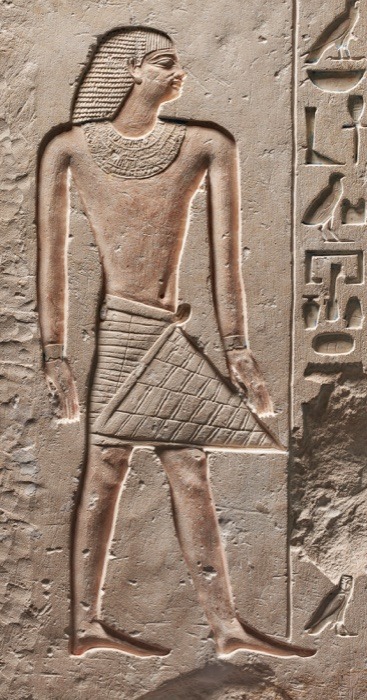
AN EGYPTIAN PAINTED LIMESTONE RELIEF FRAGMENT
OLD KINGDOM, 6TH DYNASTY, REIGN OF PEPI II, CIRCA 2278-2184 B.C.
Pepi II Neferkare (2284 BC – after 2247 BC, probably either c. 2216 or c. 2184 BC was a pharaoh of the Sixth Dynasty in Egypt's Old Kingdom who reigned from c. 2278 BC. His second name, Neferkare (Nefer-ka-Re), means "Beautiful is the Ka of Re". He succeeded to the throne at age six, after the death of Merenre I.
Pepi II's reign marked a sharp decline of the Old Kingdom. As the power of the nomarchs grew, the power of the pharaoh declined. With no dominant central power, local nobles began raiding each other's territories and the Old Kingdom came to an end within a couple of years after the close of Pepi II's reign.
#AN EGYPTIAN PAINTED LIMESTONE RELIEF FRAGMENT#OLD KINGDOM#6TH DYNASTY#REIGN OF PEPI II#CIRCA 2278-2184 B.C.#limestone#limestone sculpture#ancient artifacts#archeology#archeolgst#history#history news#ancient history#ancient culture#ancient civilizations#ancient egypt#egyptian history#egyptian hieroglyphs#egyptian mythology#egyptian antiquities#egyptian pharaoh#egyptian art
18 notes
·
View notes
Text
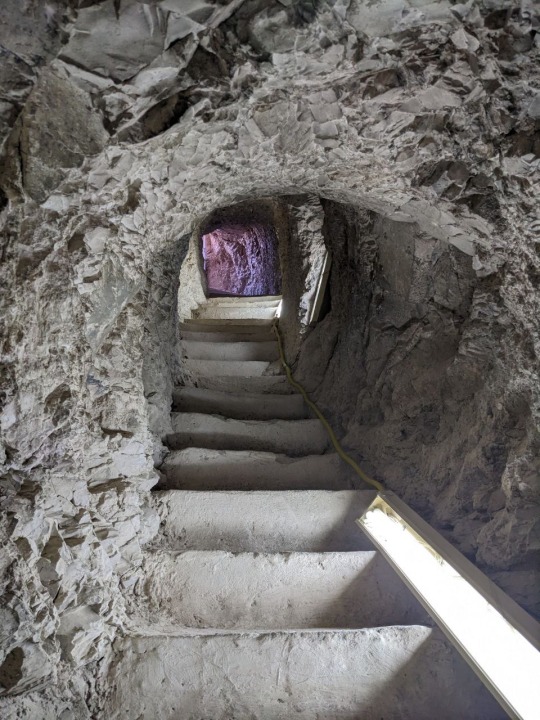
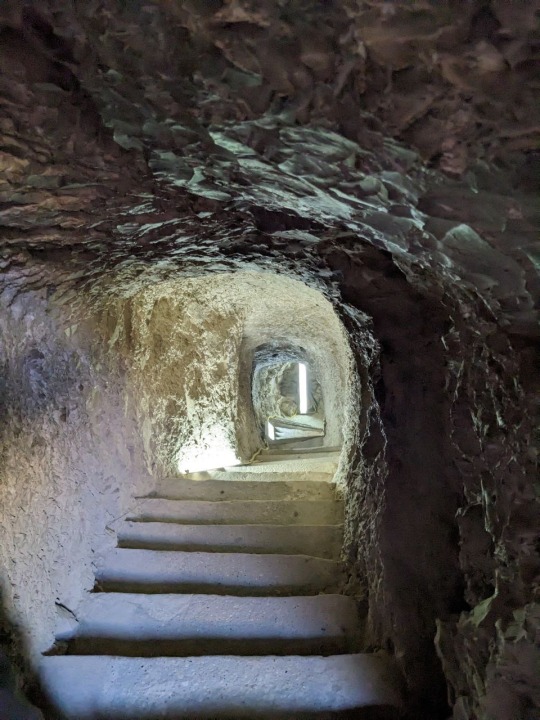

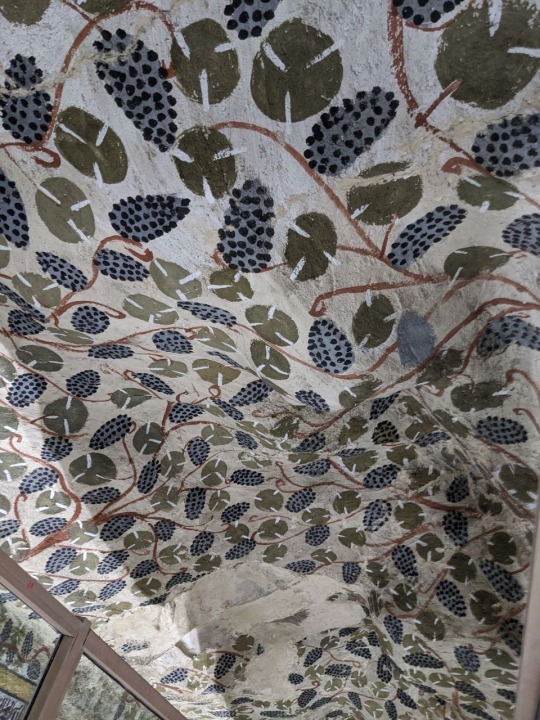


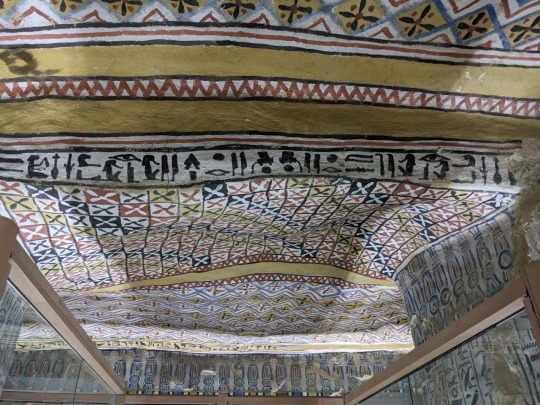
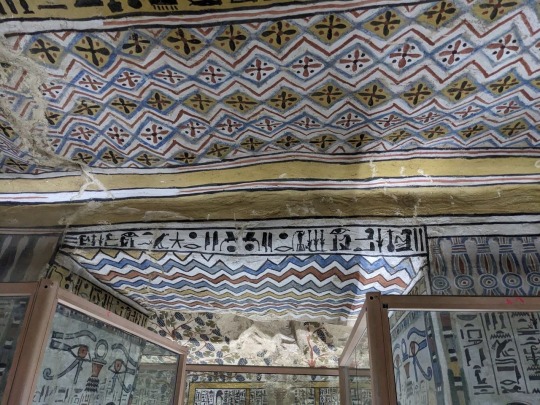
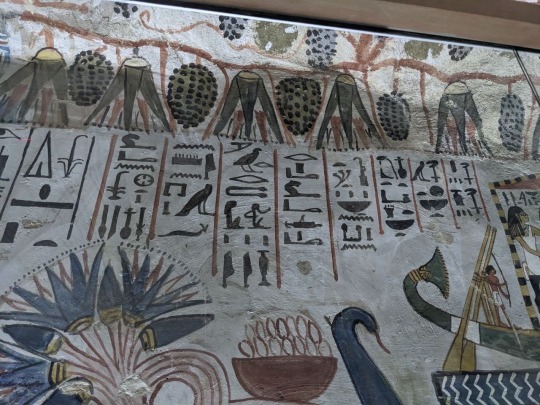

Ceiling and imagery of the Tomb of the Vineyards, burial of Sennefer, Mayor of the Southern City, Thebes, during the 18th dynasty of Egypt.
Photos taken by me, August 2023
It’s hard to tell which way is up and down when walking through the tunnel leading from the surface into the tomb. Before entering the main chamber there is a small antechamber whose ceiling is quite low, and then a shallow arch which leads to the main room depicted in the above photographs. Both chambers contain a good deal of paintings, however the main chamber holds the most numerous and well preserved paintings, of course. Besides the ceiling, everything is encased in glass.
#ancient egypt#egyptian mythology#egyptian hieroglyphs#egyptian art#ancient history#egyptian gods#egyptology#hieroglyphs#archaeology#egyptian history#egypt
2K notes
·
View notes
Text
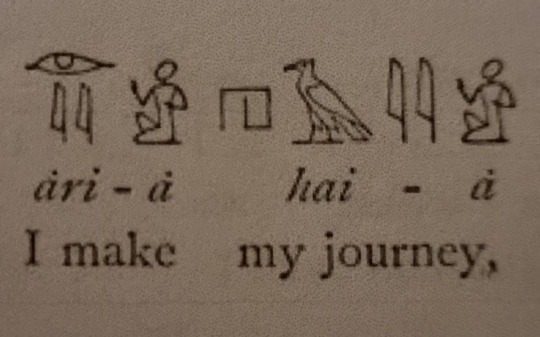
#hieroglyphics#egypt#egyptian#ancient egypt#ancient egyptian#kemet#kemetic#مصر#شمال افريقيا#north africa#north african#masr#egyptian hieroglyphs#hieroglyph#mediterranean
6K notes
·
View notes
Text
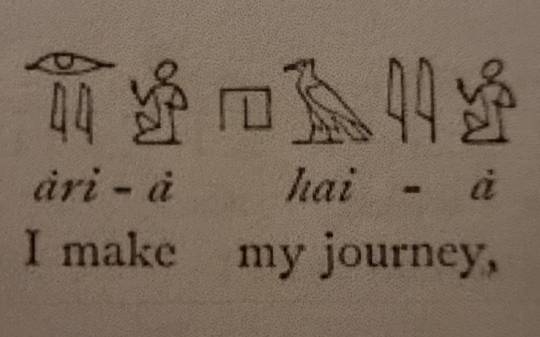
#egyptian hieroglyphs#egyptian langblr#kemetic#kemet#egyptian#kemetism#hieroglyphics#hieroglyphics reading#kemeticism#egyptian architecture
4K notes
·
View notes
Text
Inside the Grand Egyptian Museum, Cairo
🇪🇬
#grand egyptian museum#cairo#ancient egypt#egyptian artifacts#secrets of the pharoahs#egyptian hieroglyphs#architectural wonder#impressive
64 notes
·
View notes
Text




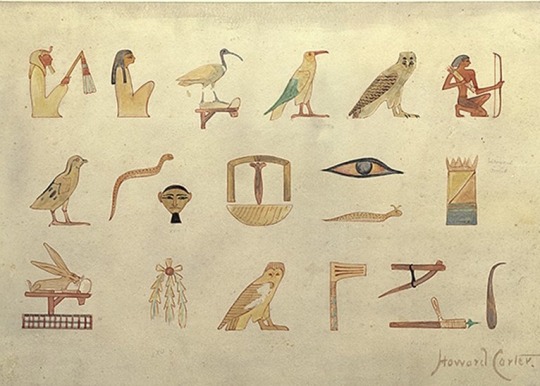

Howard Carter, Egyptology Illustrations, circa 1890s-1920s
#egyptian#egyptology#illustration#illustrator#illustration art#archaeology#egyptian history#egyptian hieroglyphs#hieroglyphs#egyptian culture#aesthetic#beauty#english artist#egyptian art#egyptian aesthetic#egyptian archaeology#aesthetictumblr#art history#tumblraesthetic#tumblrpic#tumblrpictures#tumblr art#tumblrstyle#artists on tumblr#modern art
64 notes
·
View notes
Text
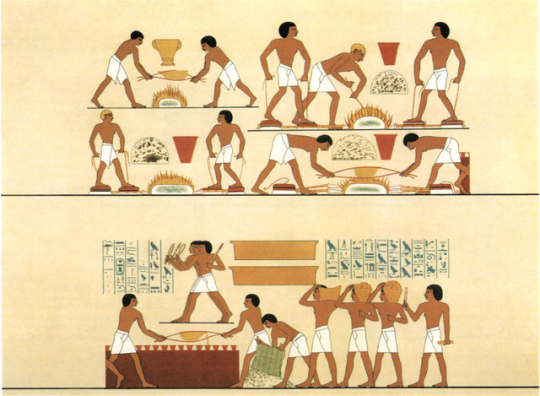
The scene showing metal workers is part of a wall depicting different professions in the tomb of Rekhmire', vizier of Tuthmosis III and Amenophis II. Above, the fires are kept ablaze with foot-operated bellows; below, the men are casting bronze doors in a large mould. The inscription states that the bronze is brought from Asia, from the land of Retjenu.
Atlas of Egyptian art. Page 119
#egyptian hieroglyphs#egyptian#kemetism#egyptian architecture#kemeticism#ancient egypt#egyptology#egyptian gods#architecture#sekhmet#Egyptian doors#door#doors#Hieroglyphics#Egyptian house
52 notes
·
View notes
Text





Strange facts about Ancient Egyptian Hieroglyphs.
I couldn't resist to make memes with this scene of Castlevania Netflix.
Just for leave context, the hieroglyphics on question are D52 and D53 of Alan Gardiner's hieroglyphics list.
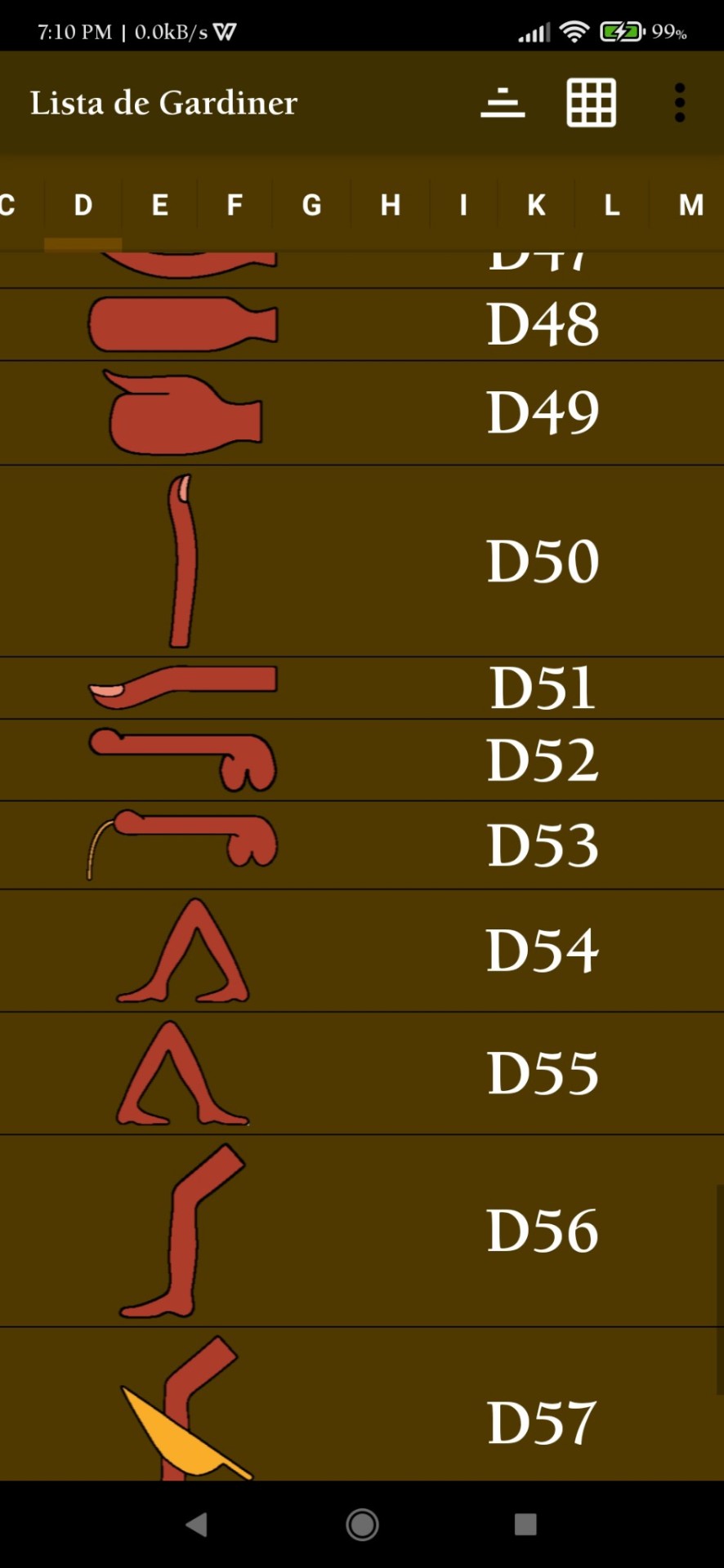
#castlevania#castlevania memes#castlevania netflix#alucard#sypha belnades#ancient egypt#hieroglyphs#egyptian hieroglyphs#ancient egypt memes
21 notes
·
View notes
Text
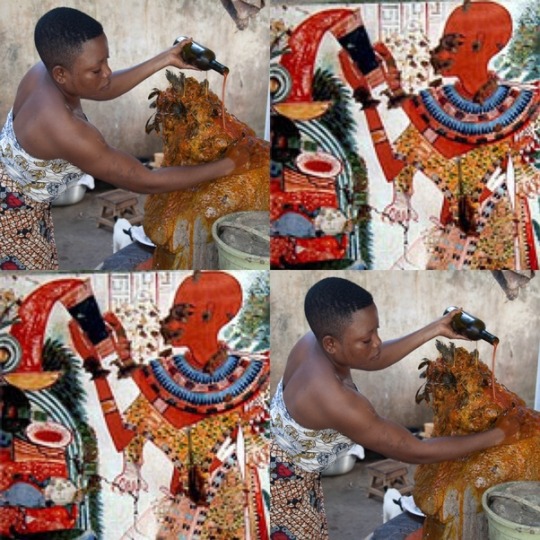
To those who say there’s no connection between West Africa and ancient Egypt you may want to revise such notions.
The oil palm (Elaeis guineensis) is a native of West Africa. It flourishes in the humid tropics in groves of varying density, mainly in the coastal belt between 10 degrees north latitude and 10 degrees south latitude. It is also found up to 20 degrees south latitude in Central and East Africa and Madagascar in isolated localities with a suitable rainfall. It grows on relatively open ground and, therefore, originally spread along the banks of rivers and later on land cleared by humans for long-fallow cultivation (Hartley 1988: 5–7).

The palm fruit develops in dense bunches weighing 10 kilograms (kg) or more and containing more than a thousand individual fruits similar in size to a small plum. Palm oil is obtained from the flesh of the fruit and probably formed part of the food supply of the indigenous populations long before recorded history. It may also have been traded overland, since archaeological evidence indicates that palm oil was most likely available in ancient Egypt. The excavation of an early tomb at Abydos, dated to 3000 B.C., yielded “a mass of several Kilograms still in the shape of the vessel which contained it” (Friedel 1897).
A sample of the tomb material was submitted to careful chemical analysis and found to consist mainly of palmitic acid, glycerol in the combined and free state, and a mixture of azelaic and pimelic acids. The latter compounds are normal oxidation products of fatty acids, and the analyst concluded that the original material was probably palm oil, partly hydrolyzed and oxidized during its long storage.

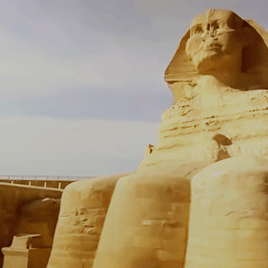
#african#afrakan#kemetic dreams#africans#brownskin#afrakans#brown skin#african culture#afrakan spirituality#vodun#voodoo#palm oil#egyptian#egyptian art#egyptian gods#egyptian history#egyptian mythology#egyptian hieroglyphs#egyptology#archaeology#ancient#ancient egypt#kemet#ancient kemet#kemetic paganism#kemetic#kemetism#sons of kemet#kemeticism#bastet
22 notes
·
View notes
Text
ancient languages summer courses
the belfast summer school in ancient languages is offering courses in beginning, intermediate, and advanced Latin and Greek, as well as Biblical Hebrew, Classical Arabic, Egyptian Hieroglyphs, and Old English, both in person at Queens University Belfast and online. prices range from GBP 75 to GBP 145 for one-two weeks of classes. information can be found here.
#isaac.txt#academia#academic accessibility#ancient languages#latin#greek#hebrew#classical arabic#hieroglyphics#egyptian hieroglyphs#old english
35 notes
·
View notes
Photo
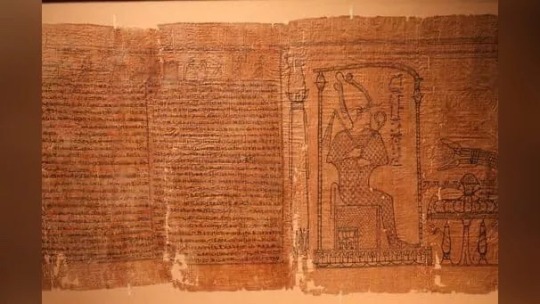
The 52-Foot-Long Book of the Dead Papyrus from Ancient Egypt
Egypt has released photos of a newly discovered Book of the Dead from more than 2,000 years ago.
Egyptian officials have released photos of an ancient scroll, the 52-foot-long (16 meters) Book of the Dead papyrus recently discovered in Saqqara. The 10 images show ancient illustrations of gods and scenes from the afterlife, as well as text on the document, which is more than 2,000 years old.
Archaeologists discovered the Book of the Dead papyrus within a coffin in a tomb near the Step Pyramid of Djoser and announced the discovery on Jan. 14 for Egyptian Archaeologists Day, but this is the first time they've released images of the scroll to the public.
It was not unusual for ancient Egyptians to bury the Book of the Dead with the deceased, but they didn't call it that at the time. Rather, modern archaeologists coined the term "Book of the Dead" to refer to a collection of texts that ancient Egyptians thought would help guide the dead in the afterlife.
Papyrus for the dead
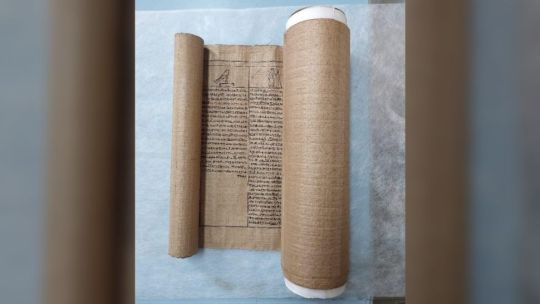
The 52-foot-long scroll was found at Saqqara in May 2022. It contains chapters from the Book of the Dead. It was recently restored and translated into Arabic and is now on display at The Egyptian Museum in Cairo. The text is written in hieratic, a script derived from hieroglyphs.
All rolled up

The papyrus was found rolled up in a coffin belonging to a man named Ahmose (not to be confused with a pharaoh who lived in earlier times). The man's name is mentioned in the papyrus about 260 times, the researchers said. He lived around 300 B.C., near the beginning of the Ptolemaic dynasty, a dynasty of pharaohs descended from one of Alexander the Great's generals.
Carefully unrolled

A team of researchers performed extensive conservation work so they could unroll the papyrus. Ahmose's tomb is located south of the step pyramid, built for Djoser, a pharaoh from the third dynasty who ruled from about 2630 B.C. to 2611 B.C. While this pyramid was built long before the time of Ahmose, it wasn't unusual to find Ahmose's tomb there, as people in ancient Egypt sometimes liked to be buried near the pyramids of long dead pharaohs.
Analyzing the scroll

The unrolled papyrus is seen here. It was written in black and red ink, and the quality of the writing indicates that it was written by a professional, researchers said. Despite the size of the scroll, there are longer Book of the Dead texts known from Egypt. For instance, a Book of the Dead papyrus, which is now in the British Museum, was originally 121 feet (37 m) long.
Book of the Dead on display

The unrolled papyrus on display at The Egyptian Museum in Cairo.
Ancient illustrations

This Book of the Dead text also contains illustrations. This image appears to show Osiris, the ancient Egyptian god of the underworld. In Egyptian mythology, Osiris' life was ritually restored after he died — something that ancient Egyptians hoped would happen to them in the afterlife.
The deity Osiris

This image shows more details about Osiris. He is shown sitting on a throne while wearing an "Atef" crown, a type of crown often gracing the head of Osiris. There appear to be offerings before him, as well as a creature who may be Ammit, a deity who consumed anyone who was not worthy of being ritually restored in the afterlife.
Husband and wife
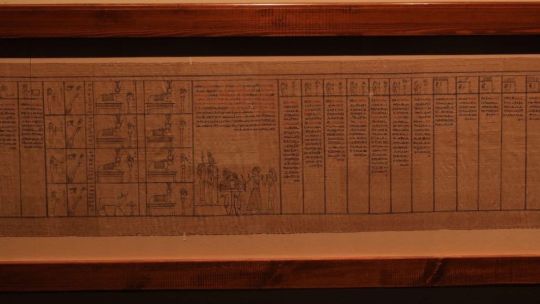
This image appears to depict offerings and a scene of a couple venerating Egyptian deities. This couple may be Ahmose and his wife (whose name is not known). Not much is known of Ahmose, but he was wealthy enough to have an elaborate copy of the Book of the Dead made for him.
Leading the cow

A number of scenes are illustrated in this section of the Book of the Dead. At the far left, a cow appears to be led somewhere — perhaps to be given as an offering. A number of images depict boats, which could be used to navigate the underworld.
Weighing against a feather
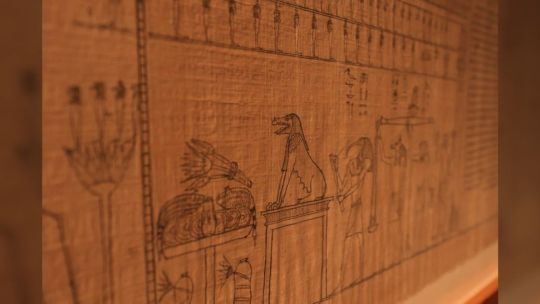
This close-up shows a creature, possibly Ammit, sitting before Osiris. In ancient Egyptian mythology, the heart of the deceased is weighed against the feather of Maat, a god associated with truth, justice and order. If the person's bad deeds in life were great, their heart would be heavier than the feather, and Ammit would devour the deceased.
By Owen Jarus.
#Book of The Dead#Saqqara#Step Pyramid of Djoser#afterlife#ancient tomb#ancient grave#ancient artifacts#archeology#archeolgst#history#history news#ancient history#ancient culture#ancient civilizations#ancient egypt#egyptian history#egyptian hieroglyphs#egyptian art#ptolemaic dynasty#ahmose#The 52-Foot-Long Book of the Dead Papyrus from Ancient Egypt
382 notes
·
View notes
Text
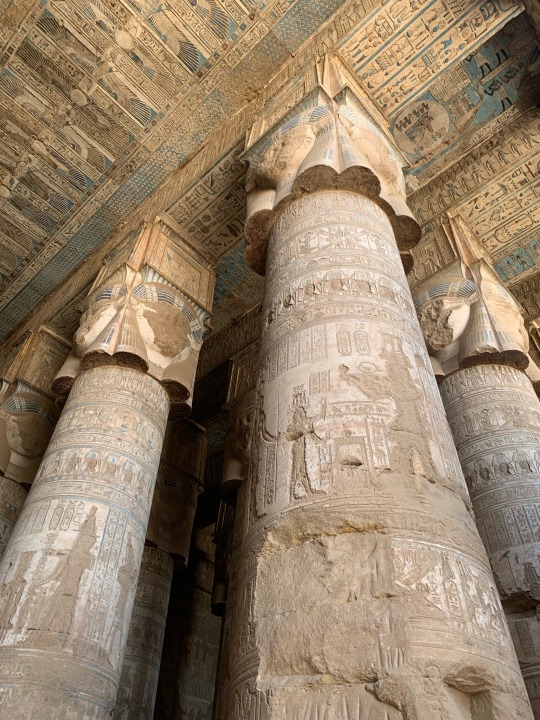
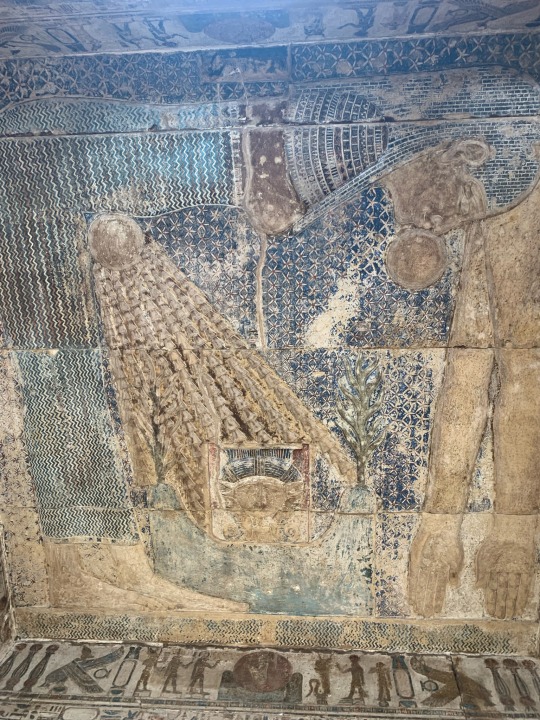


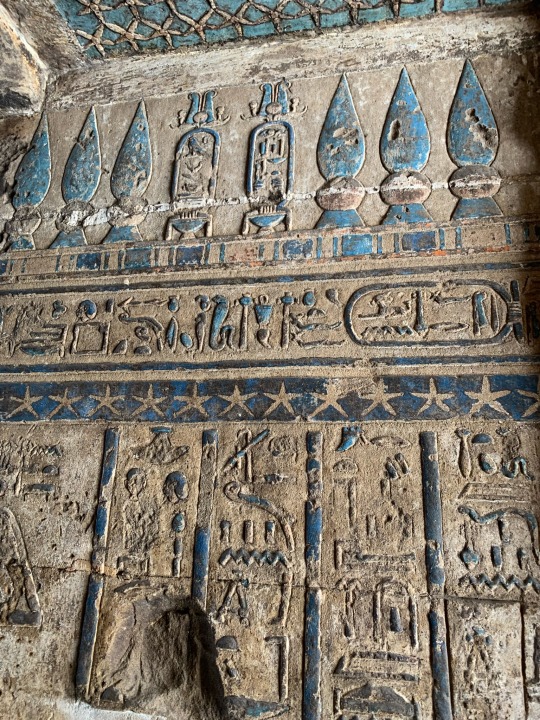



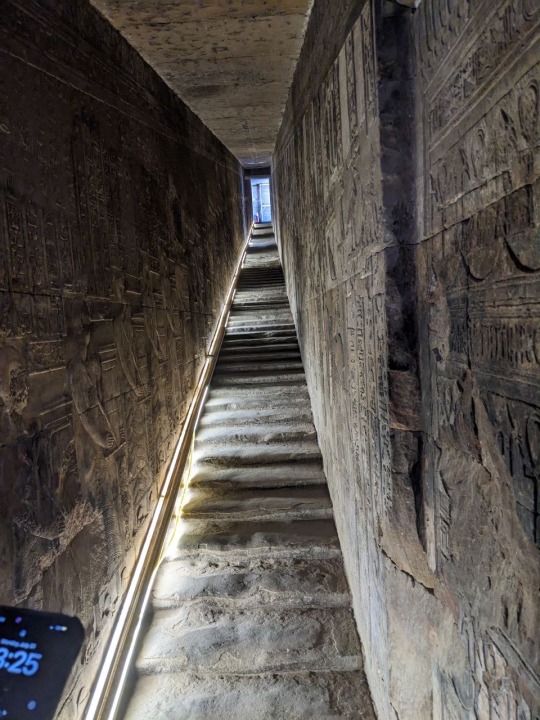

Scenery and imagery from the Hathor temple at Dendera, built in the Greco-Roman period
photos taken by me in August, 2023
Some parts of this temple, when I visited, were off limits. However it was very hard to distinguish what was and wasn’t off limits, so my companion and I wandered everywhere. We also bought passes to the different hidden chambers of the temple; well worth the price in my opinion. You descend or ascend cramped, steep stairs to get to seemingly secret and certainly hidden tunnels filled with vivid imagery of the Gods and worship. Unfortunately, the Dendera calendar filled with zodiacs, has been stolen and replaced with a black cast of what it once was. The original now rests in a museum in Europe.
#ancient egypt#dendera#Hathor#egyptian mythology#egyptian hieroglyphs#ancient history#egyptian gods#egyptian art#egyptology#ancient art#hieroglyphs#egypt
1K notes
·
View notes
Text
Divination with Hieroglyphs!
Hello hello! I recently saw a Discord Bot that offered hieroglyphics as a form of divination and then I ended up on a very deep dive about hieroglyphs for divination because the source for that bot was a site on Wicca and it was literally the only one that I could find. I'm not going to name either the bot or the website because I don't really think that we should like, shit on them and frankly that's not the intent of the post lol. Anywho!
Hieroglyphs have, historically, not always been used for divination, but in today's world they absolutely can be used! If you're interested in learning more, the rest is below the cut so that it wouldn't be a crazy long post on your dash lol
So, there are like a couple hundred to a couple thousand different hieroglyphs in total that we've found, and it would be incredibly impractical to use all of them for divination. There are 23 ones that are used by the bot and that are listed on the website (though their names are wrong lol), and then there are a bunch more that I, personally use, so I thought I'd make a post to share them!
All of these names (with the exception of one, which I will note in the list) are the names that Egyptologists have given them, and the hieroglyph meanings are derived from both their general like, appearance, and the esoteric meanings that Egyptologists have been able to discern. The letter-number combination in parenthesis beside each one references the Gardiner code and the unicode associated with it.
So the 23 that are listed on the website and the 23 that are used by the bot are as follows (these are the correct names, and not the names used by either the site or the bot):
The Mouth (D21, U+1308B): communication, meetings, working out details with others
The Forearm (D36, U+1309D): receiving something positive; a gift of fate, the help of another, things falling into place unexpectedly without any effort
The Hand (D46, U+130A7): personal skill and ability, being able to make the situation however you want it to be
The Leg (D56, U+130BE): travel, movement, influences from other locations or people
The Egyptian Vulture (G1, U+1313F): a need for emotional distance from the situation, stepping back, not getting caught up, the emotions of the moment may be blinding, looking at the situation from a distance
The Owl (G17, U+13153): wisdom, insight, knowledge, having an overview of the situation and seeing it clearly
The Quail Chick (G43, U+13171): new beginnings, new directions, new doors opening, opportunity, potential
The Cobra (I10, U+13193): power and authority, taking a humble role and working within a system controlled by others
The Reed (M17, U+131CB): growth, expansion, business with many projects, creativity, self-expression
The Double Reeds (M17A, U+131CC): over-extension, too many obligations and too much to do, taking on more than you can handle, a need to cut back and simplify
Slope of Hill (N29, U+1320E): challenges and difficulties, an uphill battle
The Door Bolt (O34, U+13283): safety, protection, lack of fear
The Stool (Q3, U+132AA): help and support of others, good advice or aid from others will be helpful
The Lasso (V4, U+1336F): unseen problems obstacles or challenges, approach with caution, second looks at a situation
The Waters/The Ripple of Water (N35, U+13216): the divine is guiding one, relax and go with the flow, divine providence
The Lying Lion (E23, U+130ED): bravery, courage, self-confidence, strength to face the situation and strength to stand up to challenges
The Tethering Rope (V13, U+1337F): wealth and prosperity, solidification of wealth and having things you desire
The Twisted Wick (V28, U+1339B): letting go of the old to make way for the new, eternity, long lengths of time, let go of what you've outgrown
The Metal Vessel (W6, U+133B5): change, transformation, development from one thing to another, from chaos to order
The Loaf of Bread (X1, U+133CF): taking care of others, fulfilling duties or requirements in a situation, necessary details, doing your part to make a situation successful
The Cup (W10, U+133BA): pleasure, joy, enjoyment, good friends ad positive situations
The Palm Branch (M4, U+131B3): success, positive attention, admiration of others, reward of effort and honor, recognition
The "Slug" (there is no hieroglyph that is named the slug, but it looks like a slug so I'm calling it the slug, and that's what the bot and the site call it) (L8, U+131AC): slow movement, patience, the situation needs to develop at its own pace, things need to fall into place before they move forward.
Other Hieroglyphs
The Crouching Man Behind the Wall (A5, U+13004): concealment, secrecy, hiding, obscured truth and lack of honesty and transparency
The Seated Man Under A Vase (A6, U+13006): cleansing your space, purifying surroundings and heart, return to a situation refreshed and with a blank slate
The Man with A Basket (A9, U+1300B): overworked and underpaid, being weighed down by too much with nowhere to rest, burnout
The Man with Tied Arms (A13. U+1300F): traitorous, harmful behavior, needing to reconsider who one trusts
The Woman Suckling Child (B5, U+13054): nourishment, concern, taking care of others, looking to others for support
The G-d with Jackal Head (C6, U+13062): Anpu, abrupt ends, weighing one's decisions carefully, considering outcomes
The Goddess with Horned Sun-Disk (C9, U+13065): Hathor, feminine joy and liberation, sexual liberation, radical joy
The Goddess with Feather (C10, U+13066): Ma'at, order, balance, stress from disorganization, anxiety of disorder
The Horns (F13, U+1310B): new beginnings, clean slates, fresh new start
The Backbone and Spinal Cords (F40, U+1312B): length, strength, extension, long-lasting, welfare
The Bee (L2, U+131A4): Neith, sweetness, unification, productivity
The Stack (M35, U+131E4): abundance, growth, reaping the benefits of what you've sown, creating abundance
The Brazier (Q7, U+132AE): light, clarity, illumination
The Loaf on Mat (R4, U+132B5): offerings, boons, pleasing experiences, pardons, being pleased or happy, at peace, count your blessings, revel in the good things in your life
Two Bows Tied Vertically (R24, U+132CB): Neith, need for protection and order
The Ankh (S34, U+132F9): life, eternal life, nourishment, protection, the soul
The Sekhem Scepter (S42, U+13302): power and control, take control of your situation, work towards the end goal of what you need
The Bow (T10, U+13314): stretched and over extended, step back and re-evaluate priorities, what is most important?
The Divided Cartouche (V11, U+13378): division, exclusion, disconnecteness, loneliness
The Crossed Diagonal Sticks (Z10, U+133F5): breaks, division, overload, getting rid of what you must.
These are not all the hieroglyphs one could use if they chose to, in fact you have a whole plethora of hieroglyphs at your disposal! Research any meanings they might have had, if they resonate with you, and then add them to your practice if you so see fit :D
#divination#divining#scrying#fortune telling#hieroglyphs#hieroglyphics#egyptian#kemetic#kemeticism#neith#anubis#anpu#witch#witchblr#witchcraft#hathor#egyptian mythology#egyptian hieroglyphs#egyptian gods#ancient egypt
123 notes
·
View notes
Text
I stand with the Palestinian civilians.
I stand to say NO for killing children and women ,smashing them into pieces.
Unfollow me if u support killing women and children
#egyptian hieroglyphs#egyptian#kemetism#egyptian architecture#kemeticism#ancient egypt#egyptology#egyptian gods#architecture#sekhmet
24 notes
·
View notes
Text
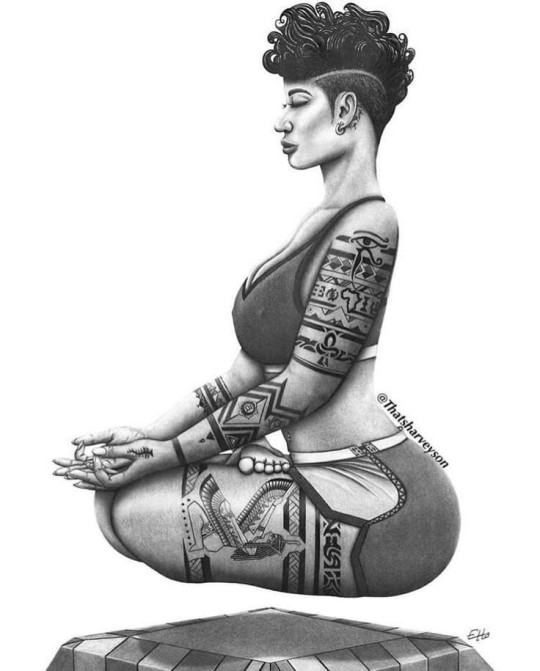
#witch#the clumsy witch#witchblr#witch blog#witch community#witchy#spiritual#witchy vibes#meditation#egyptian hieroglyphs#black art
158 notes
·
View notes
Text

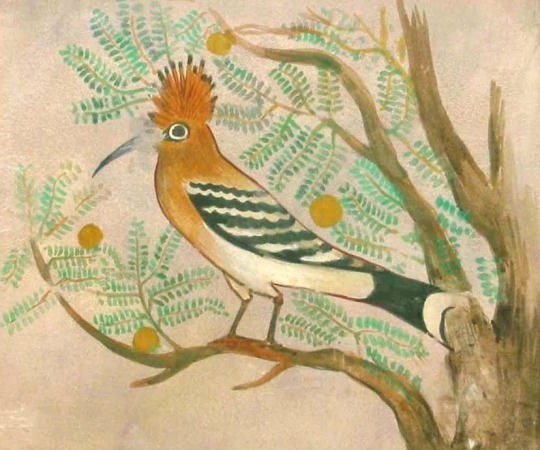
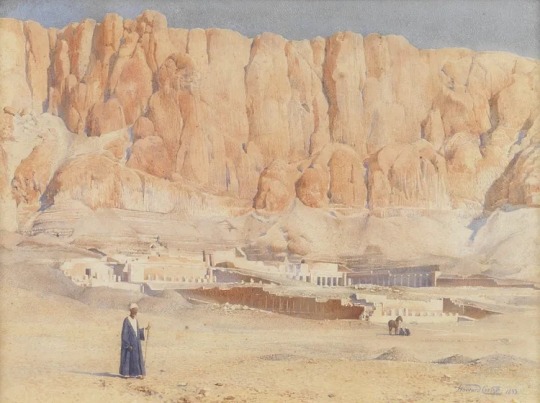

Red-backed Strike, Beni Hasan, illustration by Howard Carter, ca. 1891
Hoopoe bird illustration by Howard Carter, tomb of Khnumhotep Il at Beni Hasan, 1891
The Temple of Hatshepsut, watercolor by Howard Carter, ca. late 1890s
Hatshepsut's Temple, photograph by Lekegian, c. 1895
#egyptology#howard carter#ancient egypt#ancient history#illustration#illustrator#archaeology#archaeological art#egyptian hieroglyphs#egyptian history#egyptian culture#Egyptian people#english artist#english painter#art history#tumblrpictures#tumblr art#birds#birds in art#beautiful birds#birds of tumblr#birdwatching#tumblrposts#nature#wildlife#aesthetictumblr#tumblraesthetic#tumblrpic#tumblrstyle#artists on tumblr
43 notes
·
View notes